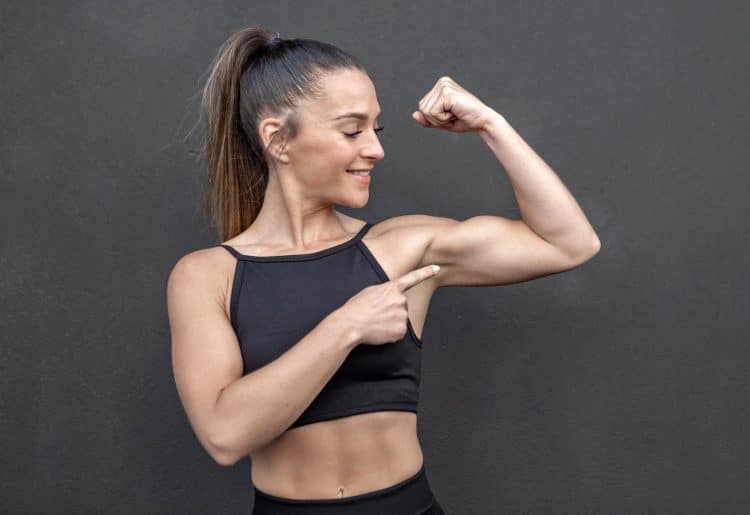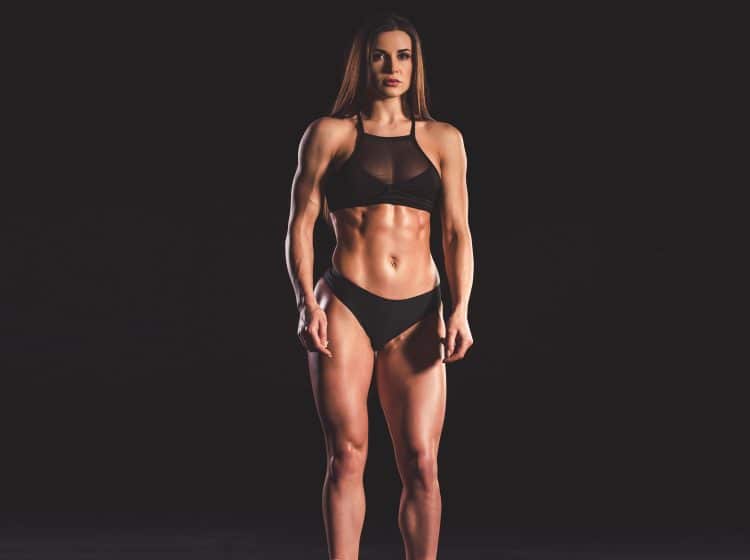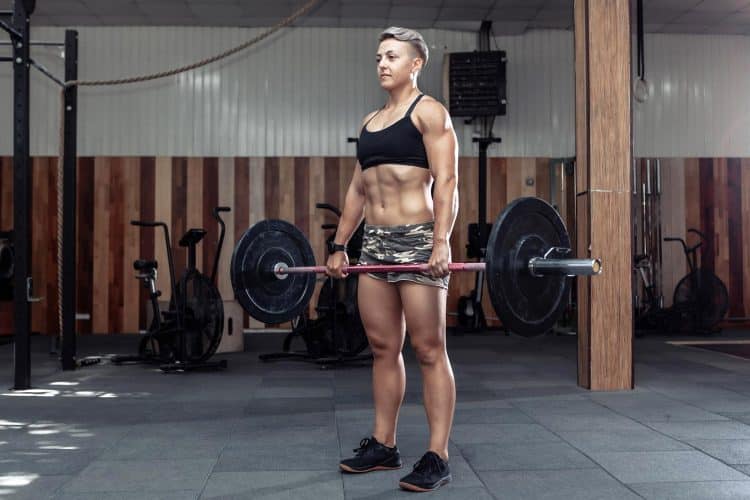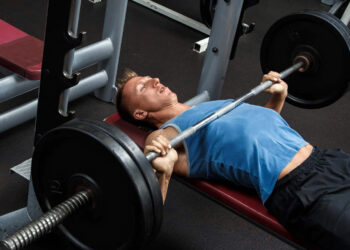While not all women want to build bigger, more visible muscles, many do.
We’re not talking about female bodybuilders or powerlifters, but regular women LIKE YOU who want to increase muscle size and sculpt their bodies to look their best.
Unfortunately, a lot muscle building advice is aimed at men, and plenty of that advice is wrong.
Following a program designed to create the next Ms. Olympia won’t help the average woman build the body of her dreams. Instead, it’ll just lead to frustration and probably put you off strength training altogether.
So, if you are a woman who wants to build muscle, this is the article for you. Think of this as your blueprint for muscle-building success.
Work hard, train smart, and you CAN build the body of your dreams!
Level Up Your Fitness: Join our 💪 strong community in Fitness Volt Newsletter. Get daily inspiration, expert-backed workouts, nutrition tips, the latest in strength sports, and the support you need to reach your goals. Subscribe for free!
Female Muscle-Building Myths
Before we get into the methods and strategies you need to use to build muscle, let’s explode a few of the most common myths associated with women and strength training.
1. Lifting weights makes you look masculine
A lot of women and people in general associate lifting weights with bodybuilding. While bodybuilders do lift weights, they do so in a very specific way, following extreme training programs designed to maximize muscle mass.
In addition to their training, bodybuilders use very specific dietary strategies to maximize muscle growth. Some also use performance-enhancing drugs called anabolic steroids.
Long story short, if you don’t train like a bodybuilder, you won’t look like a bodybuilder. Most women build muscle very slowly and won’t develop masculine-looking muscles by accident.
And if you should feel your muscles are getting too big, all you need to do is dial back on your training, and you’ll soon start to lose some of the mass you’ve gained. However, the likelihood that you’ll need to do this is slim to none.
2. Women should only lift light weights for high reps
This is a very pervasive myth, and several high-profile celebrity trainers suggest that women should not lift weights exceeding 10-20 pounds. There is a name for people like this – idiots!
The idea is this: If you want to tone up and develop feminine-looking muscles, you should work out with light weights and do high reps. Programs for women often suggest 30-50 reps per set with weights that are less than the average handbag or purse.
However, for muscles to grow and get stronger, they need to be challenged. Easy workouts won’t get the job done.
Also, most women don’t just want bigger muscles for the sake of it; they also want to get stronger. Strength is sexy and also helps make women more confident and independent. Light weights do NOT build strength.
There is a time and a place for low-weight, high-rep training, but if you want to build muscle, your weights and workouts need to be challenging.
3. Wide grip or wide stance equals wide muscles
This myth was started by a popular celebrity trainer, but despite being “utter bollocks,” some women still believe it.
The idea that the position of your hands or feet makes your muscles grow wider is ludicrous and has no foundation in science. You might as well say that eating green foods turns you green or that sitting down makes you shorter.
While you can change the effect of an exercise by changing your hand or foot position, those effects do not include muscle width. In fact, oftentimes, a wide grip or hand position works better than the narrower alternative.
Examples include wide-stance squats – a wonderful leg exercise that hammers your inner thighs, and wide-grip lat pulldowns, which is a very effective upper back exercise. Wide-grip bench presses are a very good chest-builder.
Wide-grip and wide-stance movements are not evil!
This myth illustrates how being famous does not always mean you know what you are talking about. That said, there are some great celebrity trainers out there, but you will have to learn to separate the good from the completely clueless!
4. Lifting weights makes you gain weight
Actually, this is less of a myth and more of an unnecessary worry. As your muscles get bigger, you may notice your weight goes up. Muscle is pretty dense, and even a modest increase in muscle size could lead to weight gain.
However, in most cases, this muscle gain is also accompanied by some fat loss. So, while your weight increases, what that weight is made up of also changes.
For example, before you start lifting regularly, you might weigh 130 pounds with 25% body fat. However, six-months later, you weigh 140 pounds with 19% body fat. These changes will leave you looking and feeling awesome, even though the scales are telling you that you’ve “failed.”
So, don’t worry too much about your body weight. Instead, focus more on how you look, how your clothes fit, and how you feel and perform. Who cares what the scales say if you like the changes you’re seeing?
5. Women can’t gain muscle and should stick to doing cardio
Look around most gyms, and you’ll see a clear division between men and women. Most of the guys will be lifting weights, while most women will be doing cardio. All of these people have fallen for myth #5!
Women CAN build muscle, providing they follow a sensible workout program. Sure, rates of muscle gain are typically slower than with men, but any progress is good progress. One thing is true; it’s much harder to build muscle if you never lift weights!
So, while cardio IS important for women, if you want to increase muscle size and strength, you need to spend at least some time on the other side of the gym and lift some weights.
Conversely, most guys should do more cardio. Men are statistically more likely to die from heart disease than women, and cardio is the best protection from heart disease.
The Benefits of Building Muscle for Women
Above and beyond the changes to your appearance, strength training can have a huge impact on your health and well-being. The benefits of strength training and building muscle for women include:
1. Reduce or reverse age-related muscle loss
Muscle mass tends to peak in your late 20s and early 30s and decreases gradually after that. This decrease is called sarcopenia and is why older people are often so weak.
Your body operates in a system of “use it or lose it,” and lifting weights helps slow the rate of muscle loss and can even reverse it. Plus, losing muscle mass is less impactful when you are more muscular in the first place.
So, if you want to avoid being a weak old woman who lacks the strength to get out of a chair or climb a flight of stairs, you need to start lifting weights and building muscle. And remember, young or old, it’s never too late to start.
2. Increase bone mass and lower the risk of osteoporosis
Like muscle mass, bone mass tends to peak in your early 30s and decrease thereafter. Age-related bone loss is called osteopenia. However, if osteopenia is allowed to progress, it can become osteoporosis, which is a medical condition characterized by brittle, porous bones that are prone to fracture.
Women are more prone to bone loss than men because their bones are less dense to begin with. Osteoporosis is also more common in women.
The main sites affected by osteoporosis are the hips, spine, and wrists. Ironically, these are the body parts that you’re most likely to land on and break if you fall over.
Lifting weights places a positive stress on your bones, and, like your muscles, your bones respond by getting stronger. Some age-related bone loss is inevitable, but it can be kept to a minimum with a regular dose of strength training.
3. Better posture
Posture is the alignment of your joints, which can be good or bad. When posture is poor, stress that should be on your bones ends up on your muscles and ligaments.
Poor posture can lead to aches and pains and also makes you look older and heavier. It causes fatigue, as maintaining poor posture requires a lot of muscle tension. Imagine leaning forward and then holding that position for hours at a time. It won’t be long before your neck and back are begging for a rest.
In contrast, good posture requires very little muscular tension and puts much less stress on your joints and tendons. Sitting and standing up straight also makes you look younger, slimmer, and more confident.
Strength training is arguably one of the best ways to improve your posture. Exercises like face pulls, deadlifts, and hip bridges target the very muscles that hold you up against the unrelenting pull of gravity.
Lifting weights and building muscle could be just what you need to improve and maintain your posture.
4. Better glucose tolerance
A lot of people adopt a low-carb diet to help them control their weight. This diet works because many people are very bad at metabolizing glucose. An alternative solution would be to get better at metabolizing carbs, so you don’t have to limit your intake.
When you eat carbohydrate, it is broken down into glucose to be used for energy. However, if you are bad at burning glucose, i.e., carb intolerant, that glucose is more likely to be converted into and stored as fat.
But, when you have good glucose tolerance, the carbs you eat will be preferentially driven into your muscles and liver and away from your fat stores. Then, when you exercise, your body will use this stored glucose to power you through your workout.
Strength training is one of the best ways to improve glucose tolerance and insulin sensitivity. So, if you hate low-carb diets, lift weights instead.
5. Increased resting basal metabolic rate
Your basal metabolic rate (BMR) is the number of calories you burn per day while at rest. A slow metabolic rate makes losing fat and staying lean harder, whereas a higher BMR makes controlling your weight easier.
Muscle is metabolically active tissue, meaning it uses calories to sustain it. So, building even a little extra muscle mass can increase your BMR.
While building muscle only has a small impact on your daily caloric expenditure, even a small bump in BMR will help you get and stay lean.
6. Better health and improved quality of life
Everyone knows that cardio is good for your heart health, and aerobically fit people also tend to be cardiovascularly healthy. However, strength training has health benefits too.
Combining cardio with lifting weights is arguably the best way to improve your overall health and could even help you live longer, which is a view backed by research (1).
So, if you want to live longer and enjoy an active, independent life in your 70s, 80s, and even beyond, it pays to include cardio AND muscle-building workouts in your training program.
7. Build the body you want
No other type of training provides you with the means to directly target each and every muscle group like strength training can. Want a bigger butt? Build it with deadlifts and hip thrusts! Want firmer arms? Do curls and pushdowns! What flatter abs? Cable crunches and woodchops are the way to go!
You can use strength training to sculpt the body you’ve always dreamed of.
The Principles of Muscle Building
The reason that a lot of women are unable to build muscle this that their workouts do not adhere to the principles of effective training. In short, they’re using the wrong tools for the job.
So, whether you write your own workouts or follow one written for you, make sure it adheres to these principles. If it doesn’t, it WILL NOT WORK!
1. Overload
Muscles only get bigger when you force them to. Lifting light weights and doing easy workouts are not challenging enough to produce the results you want. Instead, you need to lift hard and heavy, taking your sets close to muscular failure.
In muscle-building terms, this is called overload.
So, if you finish your set feeling like you could have kept going, you probably haven’t done enough to trigger hypertrophy. But, if your last couple of reps were hard and you struggled to complete them in good form, you have probably done enough to pull the trigger on muscle growth.
2. Progressive workouts
Leading on from the point above, the workout you did today will probably not be as effective tomorrow. That’s because, as your muscles grow and get stronger, it takes more work to challenge them and stimulate another growth spurt.
Subsequently, your workouts must be progressive, meaning that they gradually become harder. This ensures that your muscles experience ongoing overload and continue to get bigger and stronger.
You can achieve this by:
- Doing more reps per set
- Using more weight
- Progressing to more demanding exercises
- Doing more sets
- Taking shorter rests between sets
- Doing your reps more slowly
- Training your muscles more often
There is no need to change your workout every week or two. Instead, make small progressive changes that add up over time.
3. Recovery
Training is a catabolic event, meaning it causes muscle breakdown and energy depletion. Muscle growth is an anabolic event and only really happens while you are resting.
As such, the best muscle-building programs balance training with recovery and avoid working your muscles too long, too hard, or too often.
For example, it would be a bad idea to train your whole body six days per week. You might make progress initially, but within a month or two, you’ll probably start to experience overtraining.
A better approach would be to train your whole body every other day or split your body down into segments and train different muscles on different days.
Level Up Your Fitness: Join our 💪 strong community in Fitness Volt Newsletter. Get daily inspiration, expert-backed workouts, nutrition tips, the latest in strength sports, and the support you need to reach your goals. Subscribe for free!
It’s generally accepted that, for muscle growth, you’ll get good results by training each major body part 2-3 times per week.
While recovery should happen naturally between workouts, rest, sleep, and nutrition are also important. For example, being overly active between workouts, not getting enough sleep, or eating unhealthily can all impede recovery and make your muscle-building training less effective.
Read more about recovery for muscle building here.
4. Specificity
The principle of specificity describes how your body adapts to the type of training you do. For example, if you lift heavy weights, you’ll get stronger, and your muscles will grow. In contrast, if you do a lot of running, your cardiovascular fitness will improve, but you probably won’t see much improvement in muscle size or strength.
So, make sure your workouts match your fitness goals. For example, if you want to build muscle, emphasize muscle-building in your workout schedule.
That’s not to say you can’t do other workouts, such as yoga, cardio, swimming, etc. However, most time and effort should be directed at what you MOST want to improve. Spending 60-70% of your time on your main goal is a good place to start.
5. Consistency and reversibility
Sadly, you cannot store fitness and strength. If you stop training, your body will gradually start to return to its pre-trained state, and your hard-won muscle mass and fitness will gradually decline.
While you won’t lose much strength and fitness if you take a couple of weeks off training, more than that will invariably begin to reverse your gains.
Because of this, you must train consistently if you want to build and then maintain bigger muscles. Building muscle is a lifestyle!
So, pick a muscle-building plan you know you can stick to. Not for a week or a month, but for the foreseeable future. Then, try to avoid taking unplanned breaks or missing workouts. Remember, too, that a short workout is better than a missed workout.
Learn more about how to be more consistent in your workouts here.
Nutrition for Muscle Growth
It’s often said that you are what you eat, and that’s especially true when it comes to nutrition for muscle growth. It doesn’t matter if you are training hard, getting enough sleep, and taking the right supplements; if your diet sucks, your progress will be slow to non-existent.
It’s beyond the scope of this article to tell you what to eat to build muscle – that’s a MASSIVE topic. But we can give you a few guidelines to get started.
1. Create a small calorie surplus
Unless you are trying to lose fat, you need to eat a little more to build muscle. This is called creating a calorie surplus. That extra energy will power you through your workouts and fuel muscle growth.
You don’t need a huge calorie surplus, and overeating will probably make you fat. But you do need to be eating enough, so, aim for a 200-300 calorie surplus per day.
Use this calculator to determine your muscle-building calorie needs.
2. Prioritize protein
There are three food groups – fat, carbs, and protein. However, protein is arguably the most important for building muscle. High-protein foods contain amino acids, which are the building blocks of life. Too little protein means your body won’t have the materials it needs for muscle repair and growth.
Make sure you are consuming enough protein by including it in all your main meals, and having protein-based snacks, too.
How much protein do you need for muscle-building? Use this protein calculator to find out!
3. Eat clean
Clean eating means building your meals and diet around natural, wholesome foods and minimizing your intake of processed and junk food. Clean foods are generally lower in calories but higher in essential nutrients. They’re also better for you.
Just like a car, your body runs best on high-quality fuel. If you put junk in, you’ll get junk out.
So, whenever you’re deciding what to eat, ask yourself if it will help or hinder your goal of building muscle. If the answer is hinder, you should probably eat something else.
That said, the occasional cheat or treat meal won’t do you any harm. The trick is not to let that cheat meal undo all your hitherto good work. Learn how to avoid sabotaging your progress with cheat meals here.
4. Hydrate
Over 60% of your body weight is made up of water, with most of that residing in your muscles. This statistic illustrates how important water is, not only for your health but for optimal workout performance.
Dehydration is rife, and many people are chronically dehydrated simply because they don’t drink enough water per day. Instead, they slake their thirst with soda, coffee, and fruit juice.
Drinking enough water is good for every aspect of your health and fitness, and that includes muscle building. It’s often said that we should consume eight 8-oz glasses of water per day, but this sort of blanket recommendation is not helpful. Exercisers generally need more water than this, as they’re losing more through sweating and exhalations.
Discover how much water you need to drink to stay hydrated by using this calculator. Then, make sure you consume at least that amount, with your intake spread throughout your day.
5. Supplement wisely
While you don’t need to use supplements to build muscle, there are times when they can be helpful. Think of supplements as effort multipliers; the harder you train and the better your diet, the more valuable they become.
Good supplements for women include:
- Creatine – for more energy, increased muscle growth, and faster recovery between sets and workouts.
- Protein powder – to make getting enough dietary protein much easier.
- Pre-workout – for more energy before training. Ideal for when you’re having one of those days when you don’t feel like working out.
- Amino acids – the building blocks your body needs for muscle repair and growth.
- ZMA – a natural sleep enhancer.
Learn more about muscle-building nutrition here.
Sample Muscle-Building Training Plans for Women
You now have all the information you need to write your own muscle-building workouts for women.
But, to save you the bother, here are two training plans for you to try. One involves three full-body workouts per week, while the other is an upper/lower body split with four weekly workouts. Use the one that best fits your schedule.
Training plan one – full-body workouts
The great thing about full-body workouts is that you only need to train 2-3 times per week. This makes them ideal for busy people who don’t want to spend every day in the gym.
However, full-body workouts can be tiring and are sometimes quite long. But they do leave you with plenty of time for rest, recovery, and pursuing other activities.
Do these workouts on non-consecutive days, e.g., Monday, Wednesday, Friday, or Tuesday, Thursday, and Saturday.
But before you begin, make sure you spend a few minutes preparing your muscles and joints for what you are about to do. Begin with 5-10 minutes of easy cardio followed by dynamic mobility and flexibility exercises for your major muscle and joints. You may also wish to do 1-2 light sets of each exercise.
Read more about warming up for strength training here.
Workout 1
| # | Exercise | Sets | Reps | Recovery |
| 1 | Squat | 3 | 6-8 | 2 minutes |
| 2 | Romanian deadlift | 3 | 8-10 | 90 seconds |
| 3 | Bench press | 2 | 8-10 | 90 seconds |
| 4 | Medium grip lat pulldown | 2 | 10-12 | 60 seconds |
| 5 | Seated dumbbell press | 2 | 10-12 | 60 seconds |
| 6 | Single-arm dumbbell row | 2 | 10-12 | 60 seconds |
| 7 | Triceps pushdowns | 2 | 10-12 | 60 seconds |
| 8 | EZ bar curls | 2 | 10-12 | 60 seconds |
Finish your workout with 2-3 sets of 2-3 of your favorite abs exercises.
Workout 2
| # | Exercise | Sets | Reps | Recovery |
| 1 | Deadlift | 3 | 6-8 | 2 minutes |
| 2 | Leg press | 3 | 8-10 | 90 seconds |
| 3 | Dumbbell bench press | 2 | 8-10 | 90 seconds |
| 4 | Close grip lat pulldown | 2 | 10-12 | 60 seconds |
| 5 | Shoulder press machine | 2 | 10-12 | 60 seconds |
| 6 | Chest supported row | 2 | 10-12 | 60 seconds |
| 7 | Cable triceps kickbacks | 2 | 10-12 | 60 seconds |
| 8 | Dumbbell curls | 2 | 10-12 | 60 seconds |
Finish your workout with 2-3 sets of 2-3 of your favorite abs exercises.
Workout 3
| # | Exercise | Sets | Reps | Recovery |
| 1 | Wide-stance squat | 3 | 6-8 | 2 minutes |
| 2 | Barbell hip thrust | 3 | 8-10 | 90 seconds |
| 3 | Incline bench press | 2 | 8-10 | 90 seconds |
| 4 | Wide grip lat pulldown | 2 | 10-12 | 60 seconds |
| 5 | Arnold press | 2 | 10-12 | 60 seconds |
| 6 | Seated cable row | 2 | 10-12 | 60 seconds |
| 7 | Overhead triceps extensions | 2 | 10-12 | 60 seconds |
| 8 | Biceps cable curls | 2 | 10-12 | 60 seconds |
Finish your workout with 2-3 sets of 2-3 of your favorite abs exercises.
Training plan two – upper body/lower body split
The main disadvantage of full-body training plans is that they force you to cram a lot of work into a single workout. This can mean that you are unable to train each muscle group as hard as you want to.
Splitting your body into upper and lower days means more time per muscle group, which may be helpful for enhancing growth. However, four workouts per week should still be manageable for most people and provide a good balance between training and resting.
There are several ways to perform this plan, including:
| Monday | Tuesday | Wednesday | Thursday | Friday | Saturday | Sunday | |
| Option 1 | W/O 1 | W/O 2 | Rest | W/O 3 | W/O 4 | Rest | Rest |
| Option 2 | W/O 1 | W/O 2 | Rest | W/O 3 | Rest | W/O 4 | Rest |
| Option 3 | W/O 1 | Rest | W/O 2 | Rest | W/O 3 | W/O 4 | Rest |
| Option 4 | Rest | W/O 1 | Rest | W/O 2 | Rest | W/O 3 | W/O 4 |
Organize your week to avoid training more than two days in a row, and you’ll be golden!
Workout 1 – upper body (a)
| # | Exercise | Sets | Reps | Recovery |
| 1 | Incline dumbbell bench press | 3 | 8-10 | 2 minutes |
| 2 | Pendlay row | 3 | 8-10 | 2 minutes |
| 3 | Cable crossover | 3 | 10-12 | 90 seconds |
| 4 | Military press | 3 | 8-10 | 2 minutes |
| 5 | Lat pulldown | 3 | 8-10 | 2 minutes |
| 6 | Cable lateral raise | 3 | 10-12 | 90 seconds |
| 7 | Dumbbell biceps curl | 2 | 12-15 | 60 seconds |
| 8 | EZ bar skull crusher | 2 | 12-15 | 60 seconds |
Workout 2 – lower body (a)
| # | Exercise | Sets | Reps | Recovery |
| 1 | Squat | 3 | 8-10 | 2 minutes |
| 2 | Romanian deadlift | 3 | 10-12 | 90 seconds |
| 3 | Walking lunge | 3 | 10-12 | 90 seconds |
| 4 | Leg extension | 2 | 12-15 | 60 seconds |
| 5 | Leg curl | 2 | 12-15 | 60 seconds |
| 6 | Seated calf raise | 3 | 10-12 | 90 seconds |
| 7 | Cable crunch | 3 | 12-15 | 60 seconds |
| 8 | Cable woodchop | 3 | 12-15 | 60 seconds |
Workout 3 – upper body (b)
| # | Exercise | Sets | Reps | Recovery |
| 1 | Bench press | 3 | 8-10 | 2 minutes |
| 2 | T-bar row | 3 | 8-10 | 2 minutes |
| 3 | Incline dumbbell fly | 3 | 10-12 | 90 seconds |
| 4 | Seated dumbbell press | 3 | 8-10 | 2 minutes |
| 5 | Assisted pull-up | 3 | 8-10 | 2 minutes |
| 6 | Dumbbell lateral raise | 3 | 10-12 | 90 seconds |
| 7 | EZ bar preacher curl | 2 | 12-15 | 60 seconds |
| 8 | Rope triceps pushdown | 2 | 12-15 | 60 seconds |
Workout 4 – lower body (b)
| # | Exercise | Sets | Reps | Recovery |
| 1 | Deadlift | 3 | 8-10 | 2 minutes |
| 2 | Leg press | 3 | 10-12 | 90 seconds |
| 3 | Rear foot elevated split squat | 3 | 10-12 | 90 seconds |
| 4 | Hip abduction | 2 | 12-15 | 60 seconds |
| 5 | Hip adduction | 2 | 12-15 | 60 seconds |
| 6 | Standing calf raise | 3 | 10-12 | 90 seconds |
| 7 | Hanging knee raise | 3 | 12-15 | 60 seconds |
| 8 | Pallof press | 3 | 12-15 | 60 seconds |
Building Muscle for Women – FAQs
Do you have a question about building muscle for women? No worries, because we’ve got the answers!
1. Can women really build bigger muscles?
Men naturally have more muscle-building testosterone than women. This means they have the potential to build bigger muscles more easily.
That said, with the right program and nutritional approach, women can still build appreciable amounts of muscle. However, most women tend to develop muscle more slowly than men and cannot build as much mass.
Thad said, a determined woman who trains and eats right will build more muscle than a man who doesn’t take his diet and training seriously.
2. Won’t bigger muscles make me look masculine?
While big, striated muscles can look masculine, most women lack the genetics to develop their muscles to that degree.
The idea that strength training makes women look manly is very outdated. Women develop muscle more slowly than men, and it takes a lot of time and effort to build manly-looking muscles. Also, and contrary to popular opinion, it won’t happen overnight – so you won’t wake up looking huge anytime soon.
So, lifting weights won’t make you look masculine. However, it will help you sculpt the body of your dreams. And remember, strong is the new sexy. Well-developed muscles will improve your appearance and boost self-confidence.
3. What are the best exercises for building bigger muscle?
As a rule, the most effective exercises for building muscle are compound in nature. Compound exercises involve multiple joints and muscles and, because they allow you to lift the heaviest weights, are more stimulating and better for gaining strength.
Examples of compound exercises that are particularly good for building muscle include:
- Squats
- Deadlifts
- Leg presses
- Romanian deadlifts
- Good mornings
- Bench presses
- Pull-ups/chin-ups
- Bent-over rows
- Overhead presses
That doesn’t mean that isolation or single-joint exercises are pointless or ineffective. However, in terms of bang for your buck, compound exercises should make up the bulk of your workouts. Use isolation exercises to finish off your target muscles rather than prioritize them.
Read more about compound exercises here.
4. How many reps should I do per set to build muscle?
Until relatively recently, it was believed that the best repetition range for building muscle was 6-12 reps per set. Anything outside of this range was considered ineffective.
However, more up-to-date research suggests that almost any number of reps can lead to muscle growth, providing you take your set close to failure, i.e., only leave 0-3 reps in reserve (2).
That doesn’t mean you should forget about the 6-12 hypertrophy range. Using that number of reps is time-efficient and produces good results. However, if you want to do more reps with a lighter weight, e.g., bodyweight squats instead of barbell squats, you can.
But, whether you use heavy loads or light weights, you MUST take your sets close to failure if you want to trigger muscle growth. Also, low-rep, heavy weight training is vastly superior for building strength.
5. Can I just train my glutes and abs?
While you could just train the muscle groups you are most interested in developing, you’ll probably look and feel better if you train your entire body fairly equally.
That said, if you have a problem area or want to emphasize a particular body part, there is no reason not to spend some extra time on it. But, if other muscle groups are allowed to fall behind and become weak, you could be storing up problems for the future.
For example, beefing up your glutes while ignoring your lower back is a fast track to lower back pain. Working your abs and not your upper back can wreak havoc on your posture.
So, feel free to do a little more for the areas of your body you want to emphasize, but don’t neglect your other muscle groups.
Closing Thoughts
It’s no exaggeration to say that all women need to build muscle. That doesn’t mean you have to become a powerlifter or bodybuilder, but you do need to work out with weights to increase and then maintain your muscle mass.
Worried about getting too big? Don’t be!
Here’s a dirty little secret about strength training; most guys find it hard to build muscle, and they’re hormonally equipped to do it. Women have, on average, one-tenth the testosterone of men. This makes much harder for women to build muscle.
The idea of strength training making women masculine is ludicrous!
It’s time for women to embrace strength training and start building muscle. It’s arguably the fastest and most effective way to sculpt the body you’ve always wanted and will do nothing but good for your long-term health and wellness.
Strength training is the REAL fountain of youth!
References:
1– British Journal of Sports Medicine: Independent and joint associations of weightlifting and aerobic activity with all-cause, cardiovascular disease and cancer mortality in the Prostate, Lung, Colorectal and Ovarian Cancer Screening Trial https://bjsm.bmj.com/content/56/22/1277
2– PubMed: Effects of different intensities of resistance training with equated volume load on muscle strength and hypertrophy https://pubmed.ncbi.nlm.nih.gov/29564973/













